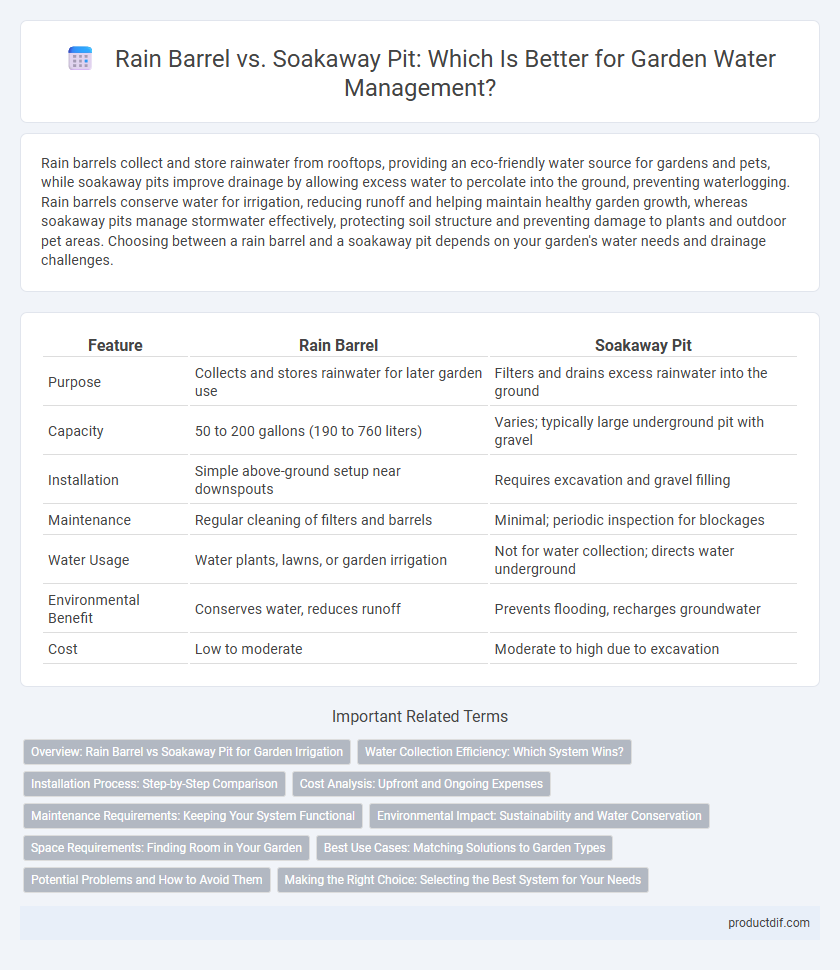Rain barrels collect and store rainwater from rooftops, providing an eco-friendly water source for gardens and pets, while soakaway pits improve drainage by allowing excess water to percolate into the ground, preventing waterlogging. Rain barrels conserve water for irrigation, reducing runoff and helping maintain healthy garden growth, whereas soakaway pits manage stormwater effectively, protecting soil structure and preventing damage to plants and outdoor pet areas. Choosing between a rain barrel and a soakaway pit depends on your garden's water needs and drainage challenges.
Table of Comparison
| Feature | Rain Barrel | Soakaway Pit |
|---|---|---|
| Purpose | Collects and stores rainwater for later garden use | Filters and drains excess rainwater into the ground |
| Capacity | 50 to 200 gallons (190 to 760 liters) | Varies; typically large underground pit with gravel |
| Installation | Simple above-ground setup near downspouts | Requires excavation and gravel filling |
| Maintenance | Regular cleaning of filters and barrels | Minimal; periodic inspection for blockages |
| Water Usage | Water plants, lawns, or garden irrigation | Not for water collection; directs water underground |
| Environmental Benefit | Conserves water, reduces runoff | Prevents flooding, recharges groundwater |
| Cost | Low to moderate | Moderate to high due to excavation |
Overview: Rain Barrel vs Soakaway Pit for Garden Irrigation
Rain barrels collect and store rainwater from rooftops for garden irrigation, providing a sustainable water source during dry periods while reducing runoff. Soakaway pits facilitate water infiltration by allowing rainwater to percolate into the ground, preventing surface waterlogging and recharging groundwater. Both systems contribute to efficient water management, with rain barrels emphasizing storage and reuse, while soakaway pits prioritize drainage and soil moisture replenishment.
Water Collection Efficiency: Which System Wins?
Rain barrels typically capture and store up to 50-100 gallons of rainwater for later use, making them highly efficient for direct irrigation and water conservation. Soakaway pits focus on infiltrating stormwater into the ground, reducing runoff and recharging groundwater but do not provide stored water for immediate use. For optimal water collection efficiency in garden supply, rain barrels win by offering accessible, stored water, while soakaway pits excel in managing excess water and preventing flooding.
Installation Process: Step-by-Step Comparison
Installing a rain barrel involves selecting a stable, level surface near a downspout, attaching a diverter or cutting the downspout to direct water into the barrel, and securing the barrel with hose attachments for easy water access. In contrast, a soakaway pit requires excavation of a deep, gravel-filled pit beneath the ground near runoff sources, lined with a permeable fabric to promote water infiltration and prevent soil clogging. Rain barrels are typically simpler and faster to install, while soakaway pits demand more labor and precise site assessment for effective drainage.
Cost Analysis: Upfront and Ongoing Expenses
Rain barrels generally have a lower upfront cost, ranging from $50 to $200 depending on size and material, with minimal ongoing maintenance expenses such as occasional cleaning. Soakaway pits require higher initial investment due to excavation and materials, often costing between $500 and $2,500, but have lower ongoing costs as they typically need little maintenance once installed. Considering water collection goals and budget constraints helps determine whether the cost efficiency of rain barrels or the long-term durability of soakaway pits is more suitable for garden water management.
Maintenance Requirements: Keeping Your System Functional
Rain barrels require regular cleaning to prevent algae buildup and blockages, ensuring the spigot and screen remain clear for optimal water flow. Soakaway pits demand periodic inspection to check for sediment accumulation and structural integrity, avoiding waterlogging and maintaining efficient drainage. Both systems benefit from seasonal maintenance to sustain functionality and extend their lifespan in garden water management.
Environmental Impact: Sustainability and Water Conservation
Rain barrels capture and store rainwater from rooftops, reducing runoff and promoting water conservation by providing a sustainable source for garden irrigation. Soakaway pits facilitate groundwater recharge by allowing stormwater to slowly percolate into the soil, mitigating flooding and enhancing soil moisture levels. Both systems contribute to environmental sustainability, with rain barrels prioritizing water reuse and soakaway pits supporting natural hydrological cycles.
Space Requirements: Finding Room in Your Garden
Rain barrels require minimal space and can be placed conveniently near downspouts, making them ideal for small gardens or urban settings. Soakaway pits demand a larger area and deeper excavation, suitable for gardens with ample space and well-draining soil. Choosing between the two depends on your garden's size, soil permeability, and available planting areas.
Best Use Cases: Matching Solutions to Garden Types
Rain barrels excel in small urban gardens where rainwater capture for container plants and lawn irrigation is prioritized, offering a space-efficient solution. Soakaway pits suit larger gardens with permeable soil, effectively managing heavy rainfall by facilitating groundwater recharge and preventing surface flooding. Selecting between these depends on garden size, soil type, and water management goals to maximize sustainability and plant health.
Potential Problems and How to Avoid Them
Rain barrels can overflow during heavy rainfall, leading to water damage or mosquito breeding if not properly sealed. Soakaway pits may clog or collapse if not constructed with adequate filtration and durable materials, causing localized flooding. Regular maintenance, using fine mesh screens for rain barrels, and incorporating geotextile fabrics around soakaway pits help prevent these issues effectively.
Making the Right Choice: Selecting the Best System for Your Needs
Rain barrels efficiently collect and store rainwater for garden irrigation, reducing water bills and conserving resources. Soakaway pits manage stormwater runoff by allowing excess water to infiltrate the soil, preventing flooding and soil erosion. Choosing the best system depends on your garden size, rainfall patterns, and intended water use, ensuring effective water management tailored to your specific needs.
Rain Barrel vs Soakaway Pit Infographic

 productdif.com
productdif.com